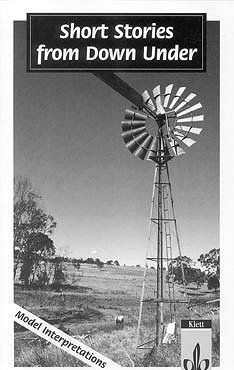3. Excerpt from: Thea Astley: "Heart is Where the Home is"
Interpretation and Teaching Notes
Introductory Information
"Tens of thousands of Aboriginal children have been taken from their families, lied to, secreted away, stolen and placed as far away as possible, sometimes overseas, to break any links with their own community. They grew up close to the missionaries, ashamed of their aboriginality, without their language or their links to the past. That was the intention" 1).
"We need to acknowledge and accept these awful aspects of our history. The point is, it´s not ancient history we´re talking about, these are lived experiences of people. It´s not something in the distant past that we can conveniently dismiss as being - 'Well that was the bad old days' sort of thing. It´s not, this is the ongoing effects of these practices which are felt every day" 2).
Indeed, Thea Astley´s short story reminds the reader of one of the most atrocious and darkest aspects of recent Australian history. However, these practices are not new, but have a long tradition starting with the first settlements on the Australian continent.
The rapid expansion of the European colonists above all in the north of the continent was accompanied by serious conflicts with the Aboriginal population. It was a common practice among the white settlers to kidnap Aboriginal women and children both for economic and sexual exploitation.
According to the 'Industrial and Reformatory School Act' of 1865 the white authorities had the right to send Indigenous children to missions which were declared to be industrial schools. In 1896 Archibald Meston wrote in his fact-finding report: " Boys and girls are frequently taken from their parents and their tribes, and removed far off whence they have no chance of returning; left helpless at the mercy of those who possessed them, white people responsible to no one under no supervision by any proper authority" 3) . He suggested to isolate the native people on reserves and his report became the basis of government policy until 1965.
The 'Aboriginal Protection and Restriction of the Sale of Opium Act' of 1897 laid the foundation of the official policy to isolate Indigenous people on missions and government reserves far away from the white population. It also enabled the removal of orphaned or deserted half-caste children to an orphanage.
The act was replaced by the 'Aboriginals Preservation and Protection Act' of 1939 and authorized government officials under the control of the Director of Native Affairs to remove native Australians or displace them from one reserve to another and separate children from their mothers respectively their families. At the same time the Director of Native Affairs was given total control of the lives of Indigenous children under 21. J. W. Bleakley, who was Chief Protector from 1913 to 1939 and Director of Native Affairs after the act of 1939, was a strong supporter of the segregation of Aborigines from non-Aboriginal people and the practices of the missions. The conditions on the missions...
The compulsory removal of children from their families and the attempt of the authorities to absorb the natives into the white population had gone hand in hand with cruel methods and had had destructive consequences. Children were hunted, grabbed at radom and taken away on trucks or later they were sent on holiday with white families but never returned and their families had no chance to find them.

INFORMATIVE ITEMS
1.
Selection Principle
2.
Didactic and Methodical Considerations
3. Excerpt from: Thea Astley, "Heart is Where the Home is"
4.
Detailed Bibliography and URLs
5.
Additional Suggestion
In the 1920s more than 80 % were girls, because on the one hand they were needed as domestic servants and on the other hand it was regarded as an adequate means to prevent them from giving birth to Indigenous babies. The situation was different after the Second World War when more boys than girls were removed for fear of increasing juvenile deliquency and to educate them and turn them into useful industrial workers...
Thea Astley´s
short story starts at the moment when a new law has been passed by
the white government saying that black children have to be brought
to a white school to be taught properly. One day policemen and government
officials come to an Aboriginal camp to take the children away. In
great confusion, "a fearful tug-o´-war", the women
try to escape with their children, whereas the men remain "sullen,
powerless before this new white law they´d never heard of".
However, Bidgi Mumbler´s daughter in law, Nelly, flees into
the shrubs with her baby, for from earlier occurrences at a camp near
Tobaccotown, where her cousin Ruthie had lost a child, she knows what
will happen. Nelly had comforted her: "You´ll have other
baby". At Tobaccotown the people had been discouraged, for they
had known that now everything was gone. "Land. Hunting ground.
River. Fish. Gone". These values had been substituted by the
white man´s world. "New god come. Old talk still about
killing. The old ones remembering the killings". A similar incident
had taken place at Tinwon 4). With her baby, Charley, Nelly stumbles
through the rain forest following the river while the police are persecuting
her...
_________________________
1) Kirsten Garrett, ABC Radio 'National, Background
Briefing Transcript', 11 February 1996, p.1
2) Mick Dodson, ibid. p.1
3) Meston, Archibald, Report on the Aboriginals of Queensland, (Queensland
Government, Brisbane), 1896, p.4
4)
Both, Tobaccotown and Tinwon are most probably fictional places, for
they do not exist in the Australian post code register. According
to an e-mail from the Australian Government services [client.services@abs.gov.au]
these places cannot be found "but it may be possible that the
names are those of farming properties or fictional place names".
Teaching Units (I - IV) ...(see Teacher´s Guide
pp. 80 - 88)
Post-Reading Activity ... (ibid. p. 88)
Contact: info@new-english-readers.de
